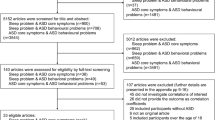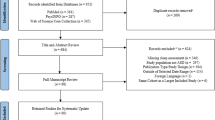Abstract
Sleep problems are a common complaint in children/adolescents with autism spectrum disorder (ASD). Correctly diagnosing and treating sleep problems in individuals with ASD is key, as they can add to the psychosocial burden of the disorder and exacerbate associated symptoms, such as inattention or irritability. Here, we provide an overview of the epidemiology, diagnosis, and management of sleep problems/disorders in children and adolescents with ASD. This narrative review is mainly informed by a systematic search in PubMed and PsycInfo (last search: 10 October 2019) of available pertinent meta-analyses. We also searched for randomized controlled trials (RCTs) published after the search date of available meta-analyses. As for the epidemiology of sleep disorders in ASD, recent meta-analytic evidence shows a pooled prevalence of 13% (95% confidence interval [CI] 9–17) in the ASD population, compared with 3.7% in the general population. In terms of diagnosis of sleep disorders, it should be based on standardized criteria [e.g., the fifth edition of the Diagnostic and Statistical Manual of Mental Disorders (DSM-5) or third edition of the International Classification of Sleep Disorders (ICSD)]; clinicians should bear in mind that the communication difficulties presented by individuals with ASD may make the diagnostic process more challenging. Regarding the treatment, a meta-analysis of behavioral interventions, including only three RCTs, found significant effects in terms of increase in total sleep time (24.41 min, 95% CI 5.71–43.11, P = 0.01), decrease in sleep-onset latency (− 18.31 min, 95% CI − 30.84 to − 5.77, P = 0.004), and a significant effect on sleep efficiency (5.59, 95% CI 0.87–10.31, P = 0.02), albeit the risk of bias of the included studies was rated “high” in relation to issues with the blinding. The bulk of the evidence for the pharmacological treatment is for melatonin, with a meta-analysis of five double-blind RCTs showing a large effect size, favoring melatonin, in sleep duration (44 min compared with placebo, Hedge’s g 1.07 [95% CI 0.49–1.65]) and sleep-onset latency (39 min compared with placebo, Hedge’s g − 2.46 [95% CI − 1.96 to − 2.98]). We conclude that additional RCTs are desperately needed to support the management of sleep disorders in ASD with an evidence-based, precision medicine approach.
Similar content being viewed by others
References
Association AP. Diagnostic and statistical manual of mental disorders (5th ed.); 2013.
(WHO) WHO. Autism spectrum disorders Fact Sheet. Updated 2017. https://www.who.int/news-room/fact-sheets/detail/autism-spectrum-disorders. Accessed 8 Feb 2020.
Lord C, Elsabbagh M, Baird G, Veenstra-Vanderweele J. Autism spectrum disorder. Lancet. 2018;392(10146):508–20.
Xue M, Brimacombe M, Chaaban J, Zimmerman-Bier B, Wagner GC. Autism spectrum disorders: concurrent clinical disorders. J Child Neurol. 2008;23(1):6–13.
Medicine AAoS. International classification of sleep disorders; 2014.
Lai M-C, Kassee C, Besney R, Bonato S, Hull L, Mandy W, et al. Prevalence of co-occurring mental health diagnoses in the autism population: a systematic review and meta-analysis. Lancet Psychiatry; 2019.
Souders MC, Zavodny S, Eriksen W, Sinko R, Connell J, Kerns C, et al. Sleep in children with autism spectrum disorder. Curr Psychiatry Rep. 2017;19(6):34.
Cummings JR, Lynch FL, Rust KC, Coleman KJ, Madden JM, Owen-Smith AA, et al. Health services utilization among children with and without autism spectrum disorders. J Autism Dev Disord. 2016;46(3):910–20.
Elrod MG, Nylund CM, Susi AL, Gorman GH, Hisle-Gorman E, Rogers DJ, et al. Prevalence of diagnosed sleep disorders and related diagnostic and surgical procedures in children with autism spectrum disorders. J Dev Behav Pediatr. 2016;37(5):377–84.
Hansen RL, Blum NJ, Gaham A, Shults J. Diagnosis of autism spectrum disorder by developmental-behavioral pediatricians in academic centers: a DBPNet study. Pediatrics. 2016;137(Suppl 2):S79–89.
Houghton R, Liu C, Bolognani F. Psychiatric comorbidities and psychotropic medication use in autism: a matched cohort study with ADHD and general population comparator groups in the United Kingdom. Autism Res. 2018;11(12):1690–700.
Houghton R, Ong RC, Bolognani F. Psychiatric comorbidities and use of psychotropic medications in people with autism spectrum disorder in the United States. Autism Res. 2017;10(12):2037–47.
Logan SL, Carpenter L, Leslie RS, Hunt KS, Garrett-Mayer E, Charles J, et al. Rates and predictors of adherence to psychotropic medications in children with autism spectrum disorders. J Autism Dev Disord. 2014;44(11):2931–48.
Meguid NA, Nashaat NH, Hashem HS, Khalil MM. Frequency of risk factors and coexisting abnormalities in a population of Egyptian children with autism spectrum disorder. Asian J Psychiatry. 2018;32:54–8.
Neumeyer AM, Anixt J, Chan J, Perrin JM, Murray D, Coury DL, et al. Identifying associations among co-occurring medical conditions in children with autism spectrum disorders. Acad Pediatr. 2019;19(3):300–6.
Díaz-Román A, Zhang J, Delorme R, Beggiato A, Cortese S. Sleep in youth with autism spectrum disorders: systematic review and meta-analysis of subjective and objective studies. Evid Based Ment Health. 2018;21(4):146–54.
Keogh S, Bridle C, Siriwardena NA, Nadkarni A, Laparidou D, Durrant SJ, et al. Effectiveness of non-pharmacological interventions for insomnia in children with autism spectrum disorder: a systematic review and meta-analysis. PLoS One. 2019;14(8):e0221428.
Adkins KW, Molloy C, Weiss SK, Reynolds A, Goldman SE, Burnette C, et al. Effects of a standardized pamphlet on insomnia in children with autism spectrum disorders. Pediatrics. 2012;130(Suppl 2):S139–44.
Cortesi F, Giannotti F, Sebastiani T, Panunzi S, Valente D. Controlled-release melatonin, singly and combined with cognitive behavioural therapy, for persistent insomnia in children with autism spectrum disorders: a randomized placebo-controlled trial. J Sleep Res. 2012;21(6):700–9.
Papadopoulos N, Sciberras E, Hiscock H, Mulraney M, McGillivray J, Rinehart N. The efficacy of a brief behavioral sleep intervention in school-aged children with ADHD and comorbid autism spectrum disorder. J Atten Disord. 2019;23(4):341–50.
Meltzer LJ, Mindell JA. Systematic review and meta-analysis of behavioral interventions for pediatric insomnia. J Pediatr Psychol. 2014;39(8):932–48.
Wachob D, Lorenzi DG. Brief Report: influence of physical activity on sleep quality in children with autism. J Autism Dev Disord. 2015;45(8):2641–6.
Brand S, Jossen S, Holsboer-Trachsler E, Puhse U, Gerber M. Impact of aerobic exercise on sleep and motor skills in children with autism spectrum disorders—a pilot study. Neuropsychiatr Dis Treat. 2015;11:1911–20.
Comments on: Behavioral teratogenic effect of methylmercury and d-amphetamine: meta-analysis and power analysis of data from the Collaborative Behavioral Teratology Study of National Center for Toxicological Research. Teratology. 1990;41(6):743–55.
Ayyash HF, Preece P, Morton R, Cortese S. Melatonin for sleep disturbance in children with neurodevelopmental disorders: prospective observational naturalistic study. Expert Rev Neurother. 2015;15(6):711–7.
Malow BA, Findling RL, Schroder CM, Maras A, Breddy J, Nir T, et al. Sleep, growth, and puberty after two years of prolonged-release melatonin in children with autism spectrum disorder. J Am Acad Child Adolesc Psychiatry. 2020.
Rossignol DA, Frye RE. Melatonin in autism spectrum disorders: a systematic review and meta-analysis. Dev Med Child Neurol. 2011;53(9):783–92.
Cuomo BM, Vaz S, Lee EAL, Thompson C, Rogerson JM, Falkmer T. Effectiveness of sleep-based interventions for children with autism spectrum disorder: a meta-synthesis. Pharmacotherapy. 2017;37(5):555–78.
Gringras P, Nir T, Breddy J, Frydman-Marom A, Findling RL. Efficacy and safety of pediatric prolonged-release melatonin for insomnia in children with autism spectrum disorder. J Am Acad Child Adolesc Psychiatry. 2017;56(11):948–57.e4.
Mehrazad-Saber Z, Kheirouri S, Noorazar SG. Effects of l-carnosine supplementation on sleep disorders and disease severity in autistic children: a randomized, controlled clinical trial. Basic Clin Pharmacol Toxicol. 2018;123(1):72–7.
Maras A, Schroder CM, Malow BA, Findling RL, Breddy J, Nir T, et al. Long-term efficacy and safety of pediatric prolonged-release melatonin for insomnia in children with autism spectrum disorder. J Child Adolesc Psychopharmacol. 2018.
Excellence NIfHaC. Autism spectrum disorder in under 19s: support and management, Clinical guideline [CG170]. https://www.nice.org.uk/guidance/cg170/chapter/1-Recommendations#interventions-for-behaviour-that-challenges. Accessed 8 Feb 2020.
Malow BA, Byars K, Johnson K, Weiss S, Bernal P, Goldman SE, et al. A practice pathway for the identification, evaluation, and management of insomnia in children and adolescents with autism spectrum disorders. Pediatrics. 2012;130(Suppl 2):S106–24.
Bruni O, Angriman M, Calisti F, Comandini A, Esposito G, Cortese S, et al. Practitioner review: Treatment of chronic insomnia in children and adolescents with neurodevelopmental disabilities. J Child Psychol Psychiatry. 2018;59(5):489–508.
Author information
Authors and Affiliations
Corresponding author
Ethics declarations
Funding
No funding was provided for this article.
Conflict of interest
Samuele Cortese declares reimbursement for travel and accommodation expenses from the Association for Child and Adolescent Central Health (ACAMH) in relation to lectures delivered for ACAMH, Canadian AADHD Alliance Resource (CADDRA), British Association of Psychopharmacology (BAP), and from Healthcare Convention for educational activity on ADHD. Fang Wang has nothing to disclose. Marco Angriman has nothing to disclose. Gabriele Masi has served on the advisory boards of Eli Lilly and Company, Shire, and Angelini. He has furthermore received research grants from Eli Lilly, Shire, and Lundbeck, and has been a speaker for Eli Lilly, Shire, Lundbeck, FB Health, and Otsuka. Oliviero Bruni has served as a consultant and provided expert testimony for both Angelini and Farmaceutici S.p.A.
Rights and permissions
About this article
Cite this article
Cortese, S., Wang, F., Angriman, M. et al. Sleep Disorders in Children and Adolescents with Autism Spectrum Disorder: Diagnosis, Epidemiology, and Management. CNS Drugs 34, 415–423 (2020). https://doi.org/10.1007/s40263-020-00710-y
Published:
Issue Date:
DOI: https://doi.org/10.1007/s40263-020-00710-y




